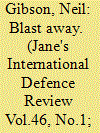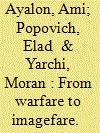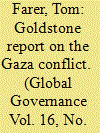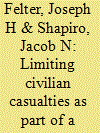| Srl | Item |
| 1 |
ID:
125764


|
|
|
|
|
| Publication |
2013.
|
| Summary/Abstract |
The recent asymmetric conflicts in Afghanistan and Iraq have shown that buried improvised explosive devices (IEDs) are a preferred method to attack the numerically and technically superior allied armoured forces.
|
|
|
|
|
|
|
|
|
|
|
|
|
|
|
|
| 2 |
ID:
089246


|
|
|
| 3 |
ID:
160128


|
|
|
|
|
| Summary/Abstract |
As part of their common efforts to undermine public support for their militarily-stronger adversaries' war efforts, insurgents and other militarily weak actors often accuse governments of fighting in a brutal manner and of committing brutal acts such as deliberately targeting innocent civilians. While sometimes there is sufficient evidence to support this claim of the government's deliberate brutality, other times militarily-weak actors will lack sufficient evidence to support this allegation. In such situation of lack of evidence, instead of making only those minimal allegations which can still be support by existing available facts, some weak actors decide nevertheless to make unsubstantiated claims and resort to fabricating the necessary evidence. This behavior presents a challenge not only for many counterinsurgent governments but also for the larger international community (most notably by diverting attention away from real atrocities). We identify some of the most common evidence-forging techniques recently employed by weak actors designed to create the factual basis to support of their chosen (often false) narratives of government brutality. The study also discusses some implications for international actors to prevent rewarding faking of atrocities.
|
|
|
|
|
|
|
|
|
|
|
|
|
|
|
|
| 4 |
ID:
144921


|
|
|
|
|
| Summary/Abstract |
Conflicts in the 21st century differ from past conflicts based on two central factors: the level of asymmetry and disparity between the actors taking part in the conflict and the amount of foreign media coverage that a conflict receives. This article aims to develop a new theoretical perspective on the implications of these two factors on how the involved states manage a conflict. Most actors in current conflicts have vast levels of disparity and receive extensive media coverage; events in those conflicts are referred to as occurrences in the “information space” because a conflict's borders are anywhere people can receive information about it. “Imagefare”—the use of images as a guiding principle or a substitute for traditional military means to achieve political objectives—is argued to be the main tool for better facing adversaries in the information space.
|
|
|
|
|
|
|
|
|
|
|
|
|
|
|
|
| 5 |
ID:
096185


|
|
|
|
|
| Publication |
2010.
|
| Summary/Abstract |
By concluding that, in its assault on Gaza under the rubric of self-defense, Israel had targeted the civilian infrastructure and consciously "punished" the civilian population and demonstrated indifference to the suffering of noncombatants and engaged in other acts in violation of the laws of war, behaviors that possibly constituted in their totality crimes against humanity, the Goldstone Report became almost as controversial as the events precipitating it. In this agora, four eminent international lawyers, a mix of scholars and practitioners, assess from their distinctive perspectives the report's methodology, its compliance with fact-finding norms, and the overall quality of its effort to apply norms of international law to a bloody event in the ongoing multidecade conflict between Jews and Arabs over the governance and division of the former British-controlled Palestinian Mandate. Dialectically, they help to structure future debates over UN-sponsored fact-finding and also the normative parameters of the use of force by powerful states engaged in asymmetrical conflicts.
|
|
|
|
|
|
|
|
|
|
|
|
|
|
|
|
| 6 |
ID:
137628


|
|
|
|
|
| Summary/Abstract |
As captured by neorealist theory, military power became increasingly relative through into the twentieth century, leading to a concentration of power within and between states—and enabling the buildup of huge colonial empires hardly a century ago. Yet since 1945, due to the overproportional effectivity gained by weaker and in particular nonstate actors it has become less relative, leading to a dispersion of power—resulting in an often violent decolonization, the
problems US and North Atlantic Treaty Organization forces have faced in Iraq and Afghanistan in dealing with comparatively small insurgencies and a growing number of failing states. Military power has a selective function: the more relative it is, the more it restricts patterns of conflict as well as the number and nature of actors relevant to international and domestic security. Today, it is because military power is becoming less relative that security policy has to adapt to increasingly asymmetric challenges.
|
|
|
|
|
|
|
|
|
|
|
|
|
|
|
|
| 7 |
ID:
139572


|
|
|
|
|
| Summary/Abstract |
Standard conceptions of the relationship between international law and war in International Relations (IR) mostly oscillate between the sceptical view that law is mostly irrelevant in times of conflict, and the optimistic view that law is a meaningful moral standard that effectively constrains violence. Modern asymmetric conflicts between liberal democratic states and non-state actors such as the Taliban, al-Qaeda, or Hamas challenge these conceptions, however, as they are at once increasingly legal and extremely violent. Drawing inspiration from IR and International Law (IL) scholarship from multiple theoretical paradigms, this article examines the legal asymmetries before, during, and after asymmetric conflict. Noting that law is at once a useful tool and a strong normative force, it argues that a good understanding of legal asymmetries can supplement existing theories of asymmetric war, continue the dissolution of false dichotomies and open up interesting avenues of research in IR, and help both scholars and policymakers understand how international law influences modern asymmetric conflict against non-state actors.
|
|
|
|
|
|
|
|
|
|
|
|
|
|
|
|
| 8 |
ID:
151759


|
|
|
|
|
| Summary/Abstract |
Military commanders in wartime have moral obligations to abide by international norms and humanitarian laws governing their treatment of noncombatants. How much risk to their own forces they must take to limit harm to civilians in the course of military operations, however, is unclear. The principle of proportionality in the law of armed conflict all but necessitates that they make a utilitarian calculation: potential harm to civilians must always be balanced against military value when considering actions that could hurt innocents. In asymmetric conflicts, such as most counterinsurgencies, information flows, collaboration, and ultimately the support of the local population can be key to achieving strategic objectives. Thus, limiting casualties to noncombatants and other actions that alienate the population in these types of conflicts is a key part of a winning strategy. The concept of “courageous restraint” was created to express this principle to NATO and U.S. forces fighting in Afghanistan.
|
|
|
|
|
|
|
|
|
|
|
|
|
|
|
|
| 9 |
ID:
055972


|
|
|